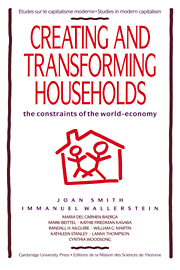Book contents
- Frontmatter
- Contents
- Preface
- I INTRODUCTION
- II THE UNITED STATES
- Introduction
- 1 The Detroit story: the crucible of Fordism
- 2 New York City: the underside of the world's capital
- 3 Binghamton: the secrets of a backwater
- 4 Puerto Rico: from colony to colony
- III MEXICO
- IV SOUTHERN AFRICA
- V CONCLUSION
- A postscript on method
- References
- Index
- Studies in Modern Capitalism
1 - The Detroit story: the crucible of Fordism
Published online by Cambridge University Press: 07 June 2010
- Frontmatter
- Contents
- Preface
- I INTRODUCTION
- II THE UNITED STATES
- Introduction
- 1 The Detroit story: the crucible of Fordism
- 2 New York City: the underside of the world's capital
- 3 Binghamton: the secrets of a backwater
- 4 Puerto Rico: from colony to colony
- III MEXICO
- IV SOUTHERN AFRICA
- V CONCLUSION
- A postscript on method
- References
- Index
- Studies in Modern Capitalism
Summary
Detroit is perhaps the quintessential American city. In many ways its history mirrors that of the nation as a whole. In the 1890s, Detroit was already a diversified manufacturing center with a fairly large immigrant population. This was the period in which the automobile industry came to dominate Detroit, and Detroit's contribution to the growing production of consumer durables that was coming to dominate the American economy. In the 1930s, Detroit was the locale of fierce class struggle. By the 1950s, the city came to epitomize the American Dream–highly paid, unionized workers whose wives stayed at home in lower-middle-class suburbia and whose children went to college. This was to last but a moment. By the mid-1960s, poverty and unemployment were becoming increasingly visible; Whites were fleeing to the suburbs and Blacks were left to deal with a city in decay. In recent years, the “flight of capital” has worsened an already bad situation for Detroit's working class as unemployment in manufacturing has increased dramatically, and unions have lost much of their bargaining power.
Detroit, of course, is the birthplace of Fordism, of that particular combination of production and consumption practices which became the hallmark of American capitalism. In Aglietta's classic account,
Fordism is a stage that supersedes Taylorism. It denotes a series of major transformations in the labour process closely linked to those changes in the conditions of existence of the wage-earning class that give rise to the formation of a social consumption norm and tend to institutionalize the economic class struggle in the form of collective bargaining … […]
- Type
- Chapter
- Information
- Creating and Transforming HouseholdsThe Constraints of the World-Economy, pp. 33 - 62Publisher: Cambridge University PressPrint publication year: 1992
- 2
- Cited by

